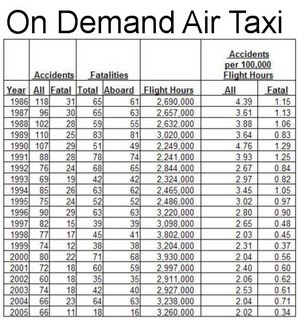Decline in Aircraft Accidents
 Did you know that the number of aircraft accidents that occur each year has gradually decreased since 1986? More importantly, the accident rate has also gone down.
Did you know that the number of aircraft accidents that occur each year has gradually decreased since 1986? More importantly, the accident rate has also gone down.If you're not a pilot (and even if you are), you might never have given it a thought.
When there's a front-page accident, such as a fully loaded airliner crashing on short final, it gets peoples' attention. As soon as the news outlets tire of that story, however, and move on to more current events, people tend to forget any previous concerns they had about aviation safety. Most people never even find out what was eventually determined to be the cause of the accident.
I used to ask my pilot students how many civil aircraft accidents they thought there were each year in this country. Their guesstimates usually ranged from a few dozen to several hundred accidents accidents a year. They were always surprised when I informed them that the annual number of accidents always hovered around 2000 or more (it has been less than 2000 per year since I retired).

These tables for accidents and accident rates come from the NTSB's Aviation Accident Statistics web page: As you can see from these tables (click on the image for a larger scale view), the airlines contribute only a small number of accidents to the total. Airline pilots receive continuous, intensive training to keep them on their toes, so it's always a bit shocking when an airliner crashes due to pilot error.
General aviation, on the other hand has a great number of pilots who get almost no training after receiving their pilot's certificate. I don't want to appear to discourage people from becoming pilots, but I think that if you aren't willing to dedicate yourself to obtaining and maintaining a high level of flying skill and aviation knowledge, you would be well advised to leave the flying to the professionals.
 GA pilots are involved in the vast majority of aircraft accidents, mostly due to a lack of basic piloting skills. Even commercial pilots (non-airline) have a considerable number of accidents, even though their basic piloting skills are much better maintained through frequent training sessions.
GA pilots are involved in the vast majority of aircraft accidents, mostly due to a lack of basic piloting skills. Even commercial pilots (non-airline) have a considerable number of accidents, even though their basic piloting skills are much better maintained through frequent training sessions.The most common cause of accidents among professional pilots, both airline and non-airline, is pilot error resulting from a loss of situational awareness. This problem has been addressed by airlines and commercial pilot training organizations over the last two decades and may account for the gradual reduction in the yearly number of accidents.
There are a number of identifiable recurring situations that tend to cause pilots to make small, but serious mistakes, and those situations are not uncommon in routine flying - especially in low visibility conditions (night and weather). They form a common thread and make many accidents almost identical to previous accidents.

Knowing what has caused previous accidents helps pilots avoid experiencing what others have already suffered. Therefore, I've encouraged pilots to review aircraft accident reports frequently. They may find one (or more) that contain flight scenarios that closely resemble some of their own flight situations that, fortunately, did not result in an accident.
I have always believed that knowing what causes accidents is a pilot's best defense against accident. Becoming familiar the "traps" that other pilots have found themselves in will better ensure that they will be able to continue to avoid getting caught in one themselves.
More important is the need to develop error recovery skills. Pilots, being human, will always make mistakes. The ability to correct those mistakes in a timely manner is what prevents them from resulting in an accident.


0 Comments:
Post a Comment
<< Home